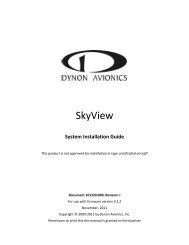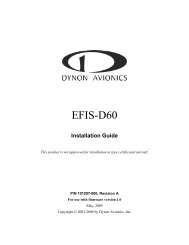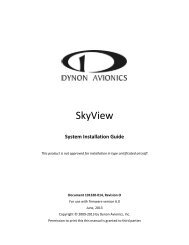EFIS-D100 Installation Guide - Dynon Avionics
EFIS-D100 Installation Guide - Dynon Avionics
EFIS-D100 Installation Guide - Dynon Avionics
Create successful ePaper yourself
Turn your PDF publications into a flip-book with our unique Google optimized e-Paper software.
Autopilot <strong>Installation</strong> and Configuration<br />
Step 9d – Allow a few minutes of stable flight under AP control<br />
Note that the AP is only flying in Altitude Hold Mode, so you will need to control the aircraft in<br />
roll. Ensure that you are not affecting the Autopilot’s control of the pitch axis, so you can<br />
determine the AP’s altitude hold and change performance.<br />
Step 9e – Adjust pitch servo TORQUE and/or SENSITIVITY values as needed<br />
On the <strong>EFIS</strong>, observe the AP status indicator (lower left corner - AP:OFF-ALT) while the AP<br />
flies. If the ALT indicator is frequently highlighted yellow, that is an indication that the Pitch<br />
Servo is slipping and the torque needs to be increased. Occasional slips due to turbulence are<br />
acceptable.<br />
If necessary, adjust the TORQUE value in the <strong>EFIS</strong> > SETUP > AP > PITCH SERVO menu.<br />
If you have adjusted the pitch servo TORQUE value to 100% and are still seeing frequent<br />
slips, you may need to move the linkage attachment point on the pitch servo 1 hole closer<br />
to the shaft. When doing this, take all precautions to ensure that an over center condition<br />
cannot occur and that the servo can provide the necessary travel for your system. If a<br />
mechanical solution is not possible, you may wish to try a higher strength servo (e.g., if<br />
you have an SV32 installed, try swapping for an SV42).<br />
After verifying that the TORQUE value is set appropriately, watch closely for AP<br />
“wandering” around the target altitude. The AP should keep the inverted triangle<br />
of the altitude bug closely aligned with the triangle of the numerical magnetic<br />
altitude indicator (as shown at right).<br />
If excessive wandering is observed, increase the SENSITIVY parameter in the <strong>EFIS</strong> ><br />
SETUP > AP > PITCH SERVO menu. If the AP control seems “twitchy” or aggressive,<br />
decrease the SENSITIVITY value. All adjustments of SENSITIVITY should be done in<br />
increments of 1 or 2, allowing you to notice subtle changes in control.<br />
Step 9f – Initiate AP-controlled climbs and descents<br />
Change the ALT bug to 500 feet above your current altitude via any of these methods:<br />
On the <strong>EFIS</strong>, enter the <strong>EFIS</strong> > AP > BUGS > ALT menu, press SEL► to highlight the<br />
hundreds digit, and press INC + to set desired altitude.<br />
On the AP74 or HS34, press the VALUE knob (or just begin rotating knob, if you have<br />
configured the VALUE KNOB settings to allow for immediate adjustment of the altitude<br />
bug) until the ALT bug adjustment window is displayed. Rotate the knob until the desired<br />
target altitude is set.<br />
As soon as the altitude bug is changed, the AP begins changing the aircraft’s altitude to follow.<br />
Repeat this step, setting the altitude bug to 500 feet below your current altitude.<br />
Step 9g – Verify pitch TORQUE and SENSITIVITY settings during climbs and descents<br />
During an AP-commanded climb, observe the AP status indicator as you did in step 9e; if<br />
excessive slipping is observed (indicated by a yellow highlight around the ALT status), then<br />
increase the pitch servo’s TORQUE parameter. Repeat this verification in a descent.<br />
6-28 <strong>EFIS</strong>-<strong>D100</strong> <strong>Installation</strong> <strong>Guide</strong>
















